Like many people born during our secular age, my primary religious instruction came from the media in general, and specifically, the best possible source: Dr. Henry “Indiana” Jones, Jr. I learned that all religions are essentially equal, that practitioners of different faiths are all worthy of respect, and that God can melt the faces off of Nazis. It was seeing Last Crusade in middle school that first got me interested in studying religion academically.
Now, a few years and a small mountain of academic training later, I look back at the Indy movies and am struck by two weird things: The main Indy trilogy is essentially a conversion narrative in which the hero never converts…which is a little strange. But second (and maybe this is the reason he never converts?): he exists in a universe where all the religions are seemingly true, based on the very real powers each movie’s main artifact displays. I’m going to spend three (lengthy!) posts exploring the weird religious universe that the first three Indiana Jones films create.
I should mention up front that I am ignoring Indiana Jones and the Crystal Skull — since it deals more with 1950s sci-fi-style alien artifacts, it doesn’t quite line up with the mystical relics of the previous three films. I’m also going to talk about the films in our chronology, not Indy’s, which is why I’m jumping into Raiders before Temple.
What’s a conversion narrative, you ask? Basically a person screws up a lot, but eventually has a realization that life, as they’re living it, is corrupt, and they make a drastic change to fix it. This narrative can be applied to any philosophy or exercise regime or diet plan, but when you deal with religion there’s usually a supernatural element – often a vision or voice, but sometimes just an emotional response. By his own account, Paul is a total jerkface until Jesus confronts him and tells him to cut out all the jerkfacedness (…I’m paraphrasing), while Augustine came to his conversion through studying Paul after a disembodied voice told him to do so. Both of Johnny Cash’s autobiographies detail years of drug abuse and tour dalliances, which he’s only able to leave behind after he becomes a more dedicated Christian. And all the versions of A Christmas Carol you’ve ever read or seen are conversion narratives in which Scrooge converts to “the spirit of Christmas” and lives his life differently after being visited by the ghosts.
The three Indiana Jones movies are similarly structured as conversion narratives. If we look at the films from Indy’s chronology, he starts as a jerkface (in Temple of Doom) and then has a series of supernatural experiences that really should change the way he looks at life and the universe. And yet, the narrative is thwarted, and he ends the series pretty much the same as how he started it—as a somewhat roguish and definitely secular adventurer.
I thought the best way to jump into the Indyverse is to look at some of the Indiana Jones knock-offs and homages that emerged after Raiders premiered in 1981. None of these films feel the need to give us treasure hunting with a side of theology, so why does Indy?
King Solomon’s Mines (1985) and Allan Quatermain and the Lost City of Gold (1986) were two of the largest Indy-esque movies of the era. Even though they went back to the original “Lost World” novels of H. Rider Hagggard for source material, Cannon pictures added enough modern touches and snark that it made the films much friendlier to an audience of kids, and updated the setting from the 1880s to WWI, which obviously echoes Indy’s pre-WWII adventuring. In both films, the heroes are fairly straightforward treasure hunters, with maybe a side of “looking for a missing relative” thrown in. For the most part, they all just want to get rich, not fight Nazis or look for God. Romancing the Stone (1984) was initially dismissed as a modern Raiders knock-off, but was so successful it warranted a sequel, 1985’s Jewel of the Nile. Both films are purely about treasure hunting gone awry, with a side of romance.
Even the illustrated style of the posters emphasize this similarity, with one giant difference: Michael Douglas’ Jack T. Colton is described as a “reckless soldier of fortune” (read: illegal tropical bird dealer) swings into his poster on a vine. Richard Chamberlain’s bandoliered Allan Quatermain is searching for a treasure – note the giant pile of gold directly next to him. Indy looks like a devil-may-care adventurer here, but he’s also not hoarding gold, or sweeping a girl off her feet, because instead he’s standing protectively in front of the Ark.
Raiders of the Lost Ark, Or, Melting Nazis
Now, to get everyone on the same page here’s a brief history of the Ark of the Covenant, pieced together from the Hebrew Bible, with some later scholarship added for context:
After the Hebrews escaped slavery in Egypt, God “dwelled” with them as they traveled across the desert. The form of God that manifested is called Shekhinah, and is the only feminine name used for the God of the Hebrews. (Some people take this to mean that this is a feminine counterpart to the Hebrew God, some people link the Shekhinah to the aspect of the Trinity that’s called The Holy Spirit, and Shekhinah makes an appearance in the Quran as the Sakīnah, and is used to mean “security” i.e.: the security that comes from having faith. Cue “The More you Know” rainbow.) Once Moses received the Ten Commandments, the Hebrews were faced with a basic problem: you’ve just been given these incredibly important rules from your God. Following them is hard enough, but how do you store them? You don’t want to, like, chip the Commandments, or accidentally put a coffee mug down on them and leave a ring. So they constructed the Ark, carried it with them, and according to lore conquered armies with the strength it gave them. Once they got to Jerusalem they gave it a permanent home in the First Temple, and it was kept in an interior room called Kodesh Hakodashim, or Holy of Holies. The powers of the Ark were mostly holding the FREAKING TEN COMMANDMENTS, but it apparently also zapped people for touching it. (A man named Uzzah died after trying to catch the Ark when a cow bumped into it, which is omnipotent dirty pool in my opinion.) At some point it was lost – either taken by Babylonian conquerors in the 580s BCE, or possibly saved and hidden along with some other icons to keep it safe from invaders. The important part, for our purposes, is that it was LOST.
After World War II, there was a flurry of books and movies detailing the atrocities of Nazis. Some of these were quite serious, like The Nuremberg Trials, while some were a little more fantastical, like all the stories about elderly SS officers hiding out in South America, and some were straight sci-fi like They Saved Hitler’s Brain! Part of this urge to catalog the Nazi’s evil was to dive into their supposed occult history. A book called The Morning of the Magicians popularized the theory that the roots of Nazism could be found in occult organizations like the Vril Society and Thule Society, and later works like The Occult Roots of Nazism provided fodder for dozens of History Channel documentaries about Nazis hunting mystical icons, which in turn inspired the movie Constantine, the Puppet Master series, Return to Castle Wolfenstein, and a whole bunch of Hellboy arcs. Now there is a small grain of truth to all of these stories: there was an organization called the Ahnenerbe, whose stated purpose was to trace Aryan history, but whose true aim was to claim that Germans were responsible for everything good in the world. The group’s founder, Heinrich Himmler, actually had the occult obsession that was later credited to Hitler (der Fuhrer’s own religious beliefs are harder to pin down, since he often tailored his statements to ensure public approval), and threaded pagan symbolism into the organization of the SS. In addition to that, after the Third Reich “annexed” Austria in 1938, they had the Hofburg Spear moved to Nuremburg. The Spear, which is one of several spears across Europe claimed to be the Holy Lance, inspired a book called The Spear of Destiny by one Trevor Ravenscroft. Ravenscroft inspired the surname of…you guessed it, Abner and Marion Ravenwood.
Steven Spielberg took this strand of popular history and ran with it for the plot of Raiders of the Lost Ark.
At the beginning of the film, Indy seems to be purely a treasure hunter. It’s only after he returns home that we learn that he’s slightly more altruistic, and was trying to get the Chachapoyan Fertility Idol for safekeeping in Marcus’ museum. (Of course, he’s still removing the idol from its home culture and context to put it on display for a probably upper-class white audience…but I’m leaving that alone for now.) He scoffs at the power of the idol and the gods behind it, and indeed the threats of the idol are just eons-old booby traps, constructed by humans to kill other humans. This sets a particular tone, as the idol is grabbed, tossed, and wielded with no reverence or respect by the western treasure hunters, but when the Hovitos see it they prostrate themselves. In the end it’s only a statue, and its power comes from the beliefs of those who consider it holy. (Now, if you look into the background of the idol, it was based on the theory that the Chachapoyan people were the descendants of Vikings, which was put forward by Nazi collaborator Jacques deMahieu. So Belloq’s interest in the idol actually falls in line with his other Nazi-funded esoterica projects.
After that opening gambit, we cut to Indy in the classroom, where he’s complaining that “local traditions and superstition” are a problem for archaeology, since laypeople will go treasure hunting and destroy historical sites in the process. While I can buy the white Ivy League historian scoffing at what he sees as primitive superstition – especially given that the “mystic powers” of the Hovitos’ idol proved to be booby traps, albeit sophisticated ones – when presented with a lead on the location of the Ark of the Covenant, he reacts with a singular mix of excitement and snark that shows he doesn’t have immediate respect for Judeo-Christian artifacts, either.
When the government stooges (one of them is Jek Porkins!) ask him about the Ark and the Staff of Ra, he outlines the history of the Ark for them. They claim that Hitler is “obsessed with the occult” but seem totally ignorant about the Ark and its history, with Indy even having to explain that it housed “the original Ten Commandments that Moses brought down from Mt. Horeb and smashed, if you believe in that sort of thing…” before asking “didn’t you guys ever go to Sunday School?”
After they exchange an embarrassed look, Dr. Jones goes on to say that the Ark may have been taken by the Egyptian Pharoah Shishak (maybe Shoshenq I?) in 980 BC(E), and that Tannis, the city that housed the Ark, was buried in a sandstorm. Spielberg uses stories from 1 Kings and 2 Chronicles to give the Ark some post-Temple closure, while skirting around the inconvenience of the Babylonians. It also brings us back to Egypt, which is a much more digestible ancient kingdom for U.S. movie audiences. All discussion of the Ark’s history stops there, though, and the ideas of its historical significance never really start in the first place. What the government guys want to know is: what does the Ark do? And why is this nefarious Adolf fellow so interested in it?
Indy, who has apparently memorized every page of the edition of the Bible that happens to be sitting in the empty classroom they’re using, opens the massive book up to an illustration of the Ark’s zappiness.
The Stooges are suitably impressed:
Stooge (horrified): Good God…
Marcus (slightly amused): Yes, that’s just what the Hebrews thought…
Other Stooge: What’s that?
Indy: Lightning. Fire. Power of God or…something…
Marcus: The army that carries the Ark before it is invincible.
Which, again, tell that to the Babylonians. But for the purposes of the movie, we’ve now just kicked into full STOP HITLER mode, and we don’t really slow down again until the end. Indy happily accepts the offer to go get the Ark, simply because he likes the idea of the artifact itself, and he hinges his agreement on the promise that Marcus will get the Ark for his museum. While the tone of the film shifts as Indy begins his search for the Lost Ark, Indy himself does not become a man on a religious quest, it’s just a race to get it before the Nazis can.
There is no discussion of the Ark as a religious artifact, no thought of the impact this find would have on Biblical studies, anti-Semitism, the rise of Nazism in Europe, people’s individual faith… nothing. Indy doesn’t call in a cavalcade of rabbis to help. It’s never considered that maybe a Judaic Studies program should be funding this mission. Frankly, I find this really weird. Obviously you don’t have time to stop for a lengthy theological conversation in the middle of an action movie, but still, some mention of…oh, wait, but the movie does do that. Sort of. When Indy worries about facing Marion for the first time in a decade, Marcus reacts with annoyance:
Brody: Marion’s the least of your worries right now, believe me, Indy.
Indiana: What do you mean?
Brody: Well, I mean that for nearly three thousand years man has been searching for the lost Ark. It’s not something to be taken lightly. No one knows its secrets. It’s like nothing you’ve ever gone after before.
Indiana: [laughing] Oh, Marcus. What are you trying to do, scare me? You sound like my mother. We’ve known each other for a long time. I don’t believe in magic, a lot of superstitious hocus-pocus. I’m going after a find of incredible historical significance, you’re talking about the boogie man.
So, here we are. They’re going after an artifact that is significant specifically because of its religious meaning, but Marcus’ attempt to reckon with that religious meaning is dismissed as hocus-pocus, and the Hebrew God is referred to as “the boogieman.” This is a boldly secular stance, both for a mid-1930s professor and for an early-1980s movie. This level of snark continues throughout the movie, and at first, the movie itself seems to support Indy’s mocking stance. The initial action mirrors the hunt for the idol at the beginning: booby traps, ancient Egyptian dioramas, roughly a billion snakes who live in a cave without a visible food source… it’s all more or less explainable. Indy and Sallah find the Ark, and they’re able to lift it and carry it around without any Uzzah-esque zappy times, so at first it seems that this is just another artifact from a long past age.
While Marcus, Sallah, and even Belloq all take the Ark seriously, Indy crashes through the quest like a fedora’d Labrador puppy, dragging Marion behind him. (Marion, meanwhile, seems predominately concerned with (a) her share of the money and (b) not getting tortured by Toht, and we never learn her feelings about the Ark itself.) Finally, the film itself weighs in on this. The camera tracks into a dark room on the Nazi ship, where the Ark has been stored in a be-swastikaed box… and we get to watch as the Ark burns the insignia off. This is something only the audience sees, as it’s the only scene in the film that doesn’t have any actors in it. In this moment, the Ark goes from being a relic of great historical significance to an actual character with agency. And it uses that agency to hate Nazis.
Finally, after all this build-up, Marion getting kidnapped, the Ark getting Ark-napped, Indy somehow surviving on a submerged submarine for an improbably long time, we get to the big scene where Indy confronts Belloq and the Nazis with a rocket launcher. We figure he’s going to rescue the ark from the evil-doers. But no! He takes aim at the Ark, and threatens to blow it up if Marion isn’t released. Belloq calls his bluff, and he backs down, only because he admits that he wants to see it opened, not because he thinks it has any intrinsic religious value. From this point on, Indy, like Marion, is utterly helpless. He is a captive just as she is, and the two of them are tied to a stake together to watch as Belloq claims his latest victory.
Here’s where it gets extra weird, and goes in a direction that most movie-goers were probably not expecting in 1981. Does Indy somehow break out and defeat his enemies? Does Marion use a combination of seductive wiles and fists to subdue a Nazi? No. All the old 1930s movie serial tropes are left by the wayside. One Nazi makes a passing reference to being uncomfortable with the Jewish ritual they were about to enact, but everyone else seems cool with it. Which makes no sense. But then Belloq, a French archaeologist who is employed by the Third Reich, and thus, presumably, not Jewish, comes out in full 6th Century BCE priestly garb.
Now here’s my question: where the hell was he keeping these historically accurate priestly robes? He has everything that Exodus 28 says a priest should wear: a pectoral, an ephod, a robe, an embroidered tunic, a turban and a belt. Was he just carrying all this stuff around with him? Was the breastplate packed under the dress he gave Marion? And more importantly: why does a French archaeologist, who is definitively not a priest of the line of Aaron, who has presumably not undertaken any of the ritual purification necessary, and who most likely does not believe in Yahweh in that highly specific Exodus-era way, think that his prayer will work? The prayer (said in Aramaic, because Belloq is one t-crossing, i-dotting bastard) is traditionally said in Temple when the Torah Ark is opened during services:
Not in human do I trust
And not on any child do I rely
In him [who] God is true
And whose Torah is true
In him will I trust
And to his name make precious praise.
Keep in mind he’s surrounded by vicious anti-Semites, who are all mostly on board with enacting a Hebrew ceremony to honor the artifact they’ve found, which, if it actually provides the direct line to God Belloq kept talking about, should immediately call into question the entire Nazi project, since it kind of means the descendants of the Hebrews are backing the correct horse, theologically speaking. No matter what happens, it won’t be in the Nazis’ favor, but they do it anyway. At first it seems the Ark is a dud, because it turns out to be full of sand.
But the sand turns out to have angry Hebrew ghosts in it, and within a few moments, they’re flying through the air, terrorizing everyone, and the Nazis all get zapped through the eyes and heart like so many Uzzahs.
All except Toht, Colonel Dietrich, and Belloq himself. Toht and Dietrich’s faces melt off, and Belloq’s head explodes, because the God of the Hebrews is apparently a Scanner.
Now here’s where it gets really, really interesting. Indy and Marion are saved from head-explodey-times by keeping their eyes closed, a demonstration of reverence in the face of the Ark’s power. But having just experienced this event, they still allow the Ark to go to Washington, rather than, say, dropping it into the ocean where no human hands could touch it again. Indy still believes that it should go to Marcus’ museum, and he still believes that humans should study its power. This seems…I don’t know… silly? Dumb? Catastrophically dumb?
Indy goes through this entire journey, which in most narratives would result in a conversion, but ends it by being pissed off at the government, and seemingly on a track to romantic bliss with Marion. He says “They don’t know what they’ve got there,” but there’s no indication that he really understands the Ark either. The audience, however, is allowed to both see the Ark at work, and watch as government agents tuck it away in the warehouse, clearly not understanding its power. This creates an interesting gap between us and Indy. Next, we’ll go forward into the past to look at Indy’s brush with Eastern mysticism in the prequel, Indiana Jones and the Temple of Doom. Will he, like so many college sophomores before him, decide that the religions of India hold his true path?
Leah Schnelbach hates to admit it, but she totally would have looked into the Ark. Come yell at her to close her eyes on Twitter!











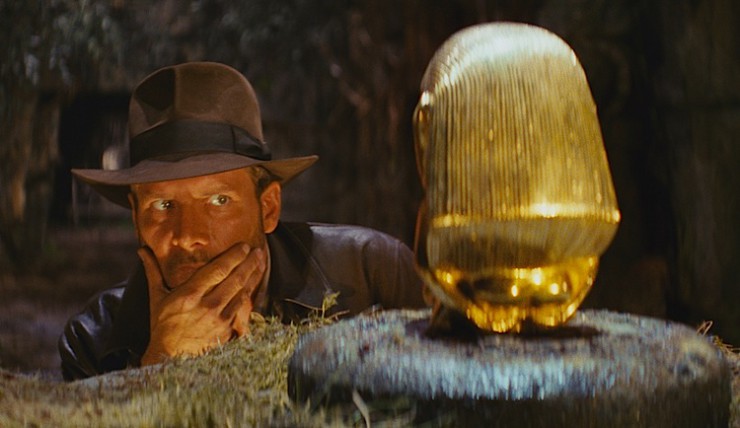
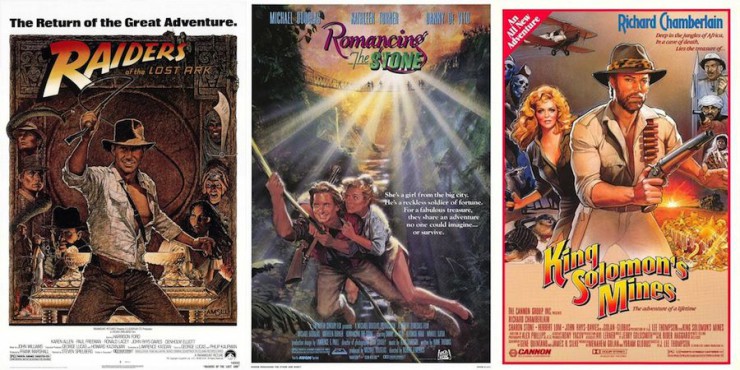

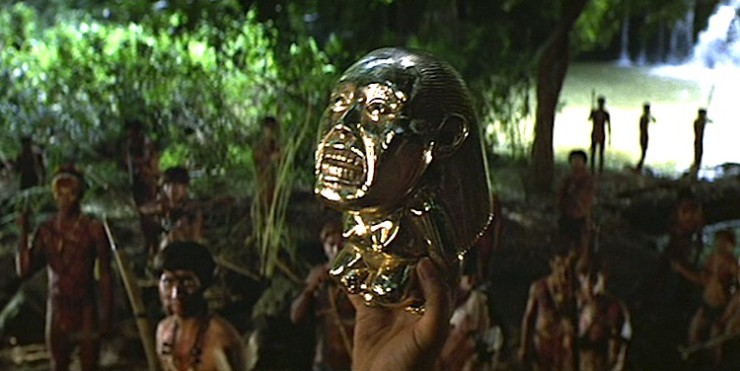
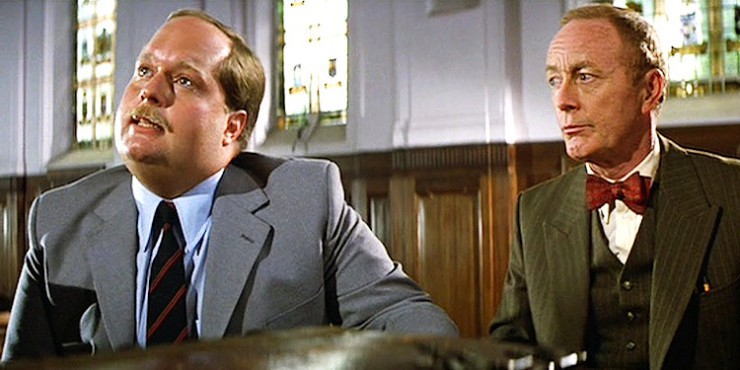
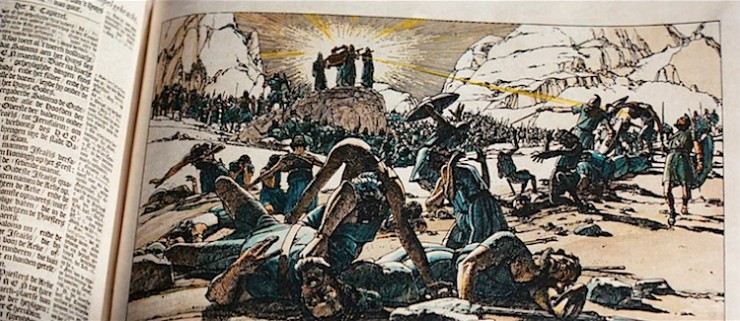
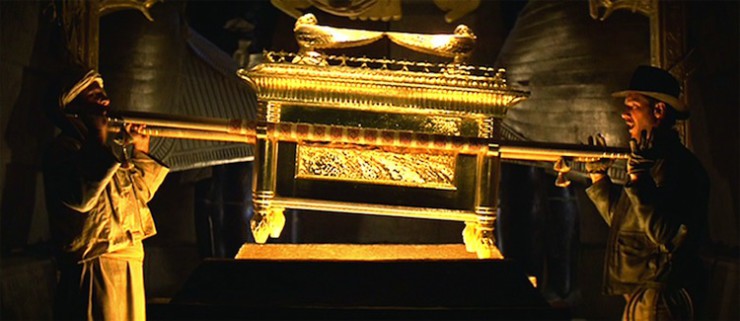
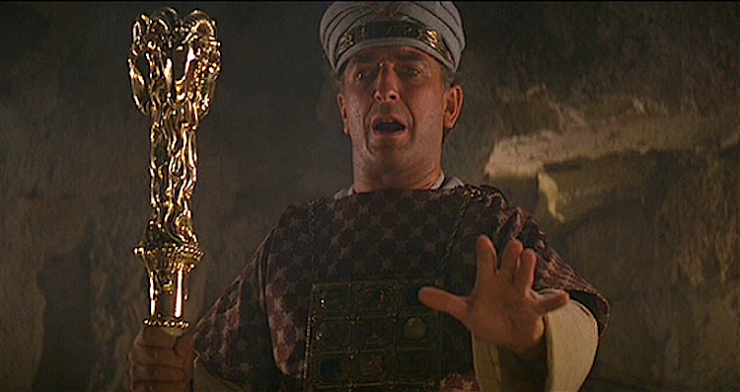

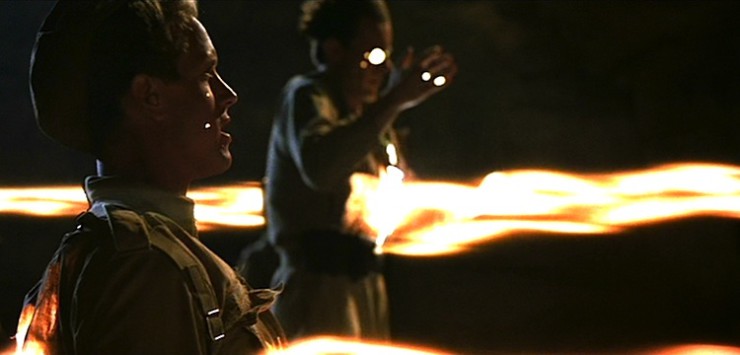
Indy doesn’t call in a cavalcade of rabbis to help.
Best remake ever. I am thinking Indy is accompanied by a chief rabbi, a grizzled sidekick rabbi, a silent martial arts rabbi, an explosives-expert rabbi, a Brooklyn-accented safecracker rabbi, a huge rugby prop-forward rabbi for hitting anyone who needs to be hit, a Polish sniper rabbi, a comic relief rabbi and possibly a rabbi who is a master of disguise (although insists on keeping his head covered whatever disguise he’s in).
But having just experienced this event, they still allow the Ark to go to Washington, rather than, say, dropping it into the ocean where no human hands could touch it again. Indy still believes that it should go to Marcus’ museum, and he still believes that humans should study its power. This seems…I don’t know… silly? Dumb? Catastrophically dumb?
Well, dropping it into the sea doesn’t sound very reverent. And it’s not particularly silly to think that the US government might soon have need of a magic box that can melt Nazis’ heads on demand. They did, after all, spend billions of dollars getting Robert Oppenheimer and Leslie Groves to build one.
Uzzah gets zapped, if I recall correctly, because God specified that the ark was to be carried by priests with wooden poles walking, and King David had put it on an Ox cart to bring it back to the Temple. The cart gets a wheel stuck in a rut and the Ark starts to fall off. Uzzah “saves” it, but the whole thing would have been unnecessary if David had followed the rules. (Which he did, some months later, after leaving the ark at the place it got stuck and checking with his prophets for advice.)
Indy and Sullah, by contrast, carry the ark properly. They may not believe, exactly, but they’ve read the rule book.
Great article. I’m now looking at the Raiders of the Lost Ark in a whole new light. Indy is not only untouched by the killer ghosts of the Ark, but entirely unimpressed by incontrovertible proof of the power of the Almighty. Heck, he even seems less impressed by the whole affair than I was to be picked to be onstage as an extra in the Indiana Jones Stunt Spectacular at Disney World, something my wife rarely brings up because it just starts me telling the whole story yet again.
At the end of Raiders, Indy still does not know that God exists or that the Jews are his Chosen People. All he knows is that the ancient Jews had a powerful magic box… which was not powerful enough to stop them from getting conquered.
BTW – if you did know that God existed and that Jews were his Chosen People and you were not Jewish, you could conclude that there was no reason to be loyal to a God that does not care about you.
I’m still thinking about the first comment. A silent martial arts rabbi? Oy vey. (Sorry, I had to say it.) Let’s see…nine rabbis in all. Is this some kind of “Ocean’s Eleven”-style story? Nine rabbis get together to break into a government warehouse? I don’t know…
This is really a great article. Looking forward to the next one.
@@@@@ Marla J — no, it’s the beginning of a joke. “An archaeologist and nine rabbis walk into a secret government warehouse…”
This article rocks! Please do more, and go into more detail!
— — —
Spoilerish, feel free to delete.
In “Last Crusade” Indy looses his temper with Jones senior, and blames him for neglecting his family for the sake of his Grail Quest. I took that as Indy having a “I WON’T be like my Father; I’ll never believe in transcendent anything” foundational element of his personality. So Transcendent things can happen right in his face and he can’t let himself believe them, because that would cause him to question his worth and his Mother’s worth versus his Father’s Grail quest. Making up with/learning to respect his Father is easy, but questioning his Mother’s or his own intrinsic worth is way too big a step. He’ll fight,flee, maybe even die; but he won’t put that belief to the question.
— — —
Also:
– WWII and earlier subs travel fastest on the surface, it’s 1936/37 so no attacks are expected.
– When Belloq told Indy he thought the Ark was a “Radio Transmitter” Spielberg and the writers were ripping a 1933 crank theory by Frederick Rogers. Some details here:
http://io9.gizmodo.com/the-engineer-who-said-the-ark-of-the-covenant-was-a-gia-1598583115
So by stepping through the ceremony thoroughly, Belloq is trying to get the Ark to connect to the “heaven” without zapping him.
– I Love the Ark as a character. I think, once it was found, it took action to have itself re-hidden. A handful of enemies of the Hebrews were disposed of, with a proper Pillar of Fire, right out of Exodus, just cause Ark is Too Cool. Then in the end, another mighty empire hides the Ark with it’s stash of secret trophies, and in due course of time, another dust storm causes the store place to be lost from the memory of man, until the day the Hebrew God calls forth his Ark for Glory!
@8 If the U-boat made its journey on the surface, it would have had a crew on top of the conning tower who would have noticed, at some point, the man clinging to the pressure hull just behind them.
I think that if it had worked out for them, the movie Nazis would have convinced themselves that the original users of the Ark were somehow Aryan and therfore it wasn’t really Jewish. That fits with the whole Ahnenerbe agenda.
Excellent article! Looking forward to “The penitent man kneels and rolls.”
As I remember it, in the novelization, Indy uses his whip to lash himself to the periscope of the submarine, which stays up during their entire undersea transit. That particular explanation makes even less sense than the other theories I have heard. And as @9 has said, no submarine runs on the surface without the conning tower being manned.
Perhaps the power of the Ark protected him, although it certainly wasn’t because his heart was pure. ;-)
Going by the in-movie chronology, Indie has already seen magical and proclaimed divine artifacts. He’s seen the stones from Temple of Doom work their magic, with that magic coming from a non-Abrahamic source. Given that a tenant of monotheism is an all powerful god, the stones do call into question the power and strength of the god of the Bible. It’s a magical box, one to treat with the respect of an armed and unexploded A-bomb, but there is no indication that there is actually a god.
@10 Or that God had abandoned the Jews in favor of the Aryans just as Christianity superseded Judaism.
And obviously the Babylonians were able to win because the Ark had already been stolen and taken to Egypt, while a fake was left at the Temple.
@@@@@ TheMadLibrarian–that’s exactly what I thought last night, right after I posted the comment! I don’t know whether to suggest the actors I was thinking of or not, but this is beginning to sound like a comedy extravaganza in my mind.
@Marla J — If someone hasn’t already made a joke about the OyVey Team, allow me to be the first.
I took the ‘angry ghosts’ in the Ark to be Angels of Death from the Exodus. Sallah makes a clear parallel between the Nazis and the ancient Pharoahs, so I think the message is that they got the same agents of divine wrath.
@1 – a1ay: I’m down for that remake. One of the rabbis has to be Mel Brooks (chief rabbi), another Zach Braff (explosives rabbi), and another Andy Samberg (comic relief rabbi).
@3 – AlanBrown: I would tell that story DAILY.
@5 – Marla J.: OyVey’s Eleven.
Mel would probably be the comic relief Rabbi
Count me in for Indiana Jones and the Cavalcade of Rabbis. There should either be 10 of them, for a minyan, or else they should be some subset of the Tzadikim Nistarim.
@9 & 11:
That scene of Indy lashing himself to the conning tower / periscope wasn’t invented for the novelization; it was scripted and filmed, and survived intact into not only the novel but the comic adaptation as well. Most of it didn’t make it into the final cut of the actual film, but towards the end of the map montage, as the U-boat is approaching the island base, you can in fact see the tiny figure of Indy still clinging to the conning tower.
@12:
The in-universe chronology also has Indy encounter an actual vampire decades earlier, when he’s a teenager, in an episode of The Young Indiana Jones Chronicles.
It always cracks me up, that movie scene of opening the Ark. Because Belloq the i-dottir and t-crosser, while dressing about right, says the traditional prayer for opening the Ark in a contemporary synagogue – that is, a cabinet where the Torah scrolls are stored.
The traditional contents of the Ark of the Covenant, OTOH, are the solid and broken Tablets, a bushel of manna, and Moses’ staff, the one that became a snake before Pharaoh. And the “traditional prayer” is a quote from the Zohar, the primary work of Jewish medieval mysticism, composed c. 1290, a good 1875 or so years since the Ark was lost, at the end of the First Temple (586 BCE). We don’t know what should have been said for opening the Ark of the Covenant, nobody was ever supposed to open it. The procedure for even approaching it is laid out in Leviticus, and involves several sacrifices.
Loved the article Leah and empathize with all your observations of the movie. Funnily enough, I wrote (and self-published – http://www.amazon.com/Sons-Kohath-Tragedy-Travesty-Tapas/dp/1502713055/ref=sr_1_1?s=books&ie=UTF8&qid=1425598036&sr=1-1&keywords=The+sons+of+kohath) a novel about a possible “real scenario” of the Ark’s discovery in Franco’s Spain in the 1970’s, including fascists and yes, rabbis!! Back in 1981, it was the Jones / Brody / boogie-man scene that made the biggest impact upon me – then a 21 year-old Ark geek and in some ways led me to writing a book about the “historical” Ark as an antidote to things like Raiders and esoteric “Ark literature” – albeit, over 30 years later. For me it was always the Ark’s “incredible historical significance” which obsessed me, and I so I always found Spielberg’s DeMille-esque climax something of a let-down – apparently Indiana Jones did too, judging by his failure to “convert”…
Great article. What always struck me as most amusing about Raiders and its descent into full-on cosmic horror (which I love about all the Indy movies–they always whip out actual magic, in a very Hereditary-esque move) is how if Indy had just stayed home and done nothing, the Nazis would have nuked themselves anyway. The Ark is confirmed to be a holy Hebrew artifact with all-powerful Jewish magic protecting it. And while it’s true that technically, by pursuing the Nazis, Indy succeeded in making sure the Ark remains safe in storage (yay, US Army?) I think if he had just stayed home, the Nazis would have found it, opened it, and died anyway. Theoretically, the Ark only kills those who are, well, evil, as it spares the lives of two “good” people. I say let them find the Ark and bring it straight to Hitler.
I think it’s interesting that the staff headdress for RA has pekoe -Hebrew writing with creators name on it, which they translate it incorrectly as GOD. Very funny.
Sorry Paleo-hebrew* got to love autocorrect.
I still vividly recall my incredulous reaction to Bellow’s decision to open the Ark. Is he nuts? Hasn’t he read the owner’s manual?? The Ark was bloody dangerous even to the Chosen People, how did he think it would react to their enemies???